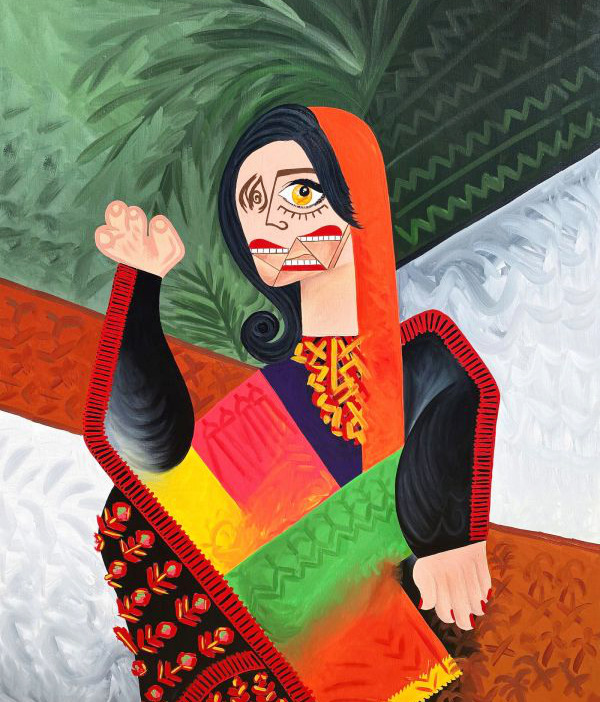JEDDAH: Saudi artist Faisal Al-Kheriji is keeping one eye on the past and the other on the future as he sets out to explore the rapid cultural changes transforming the Kingdom.
The 27-year-old artist draws on cubism and surrealism — art styles that originated more than a century ago — to create distinctive portraits showing how Saudi Arabia is modernizing and adapting to change.
Al-Kheriji’s artworks deal with subjects ranging from social customs to hospitality and styles of dress.
“I get inspired by my culture and by other artists, both globally and locally,” he said.
Al-Kheriji, who was born and raised in Jeddah, began to paint at the age of six and soon began attending art classes.
“Painting grew with me as a hobby, but I was self-taught after that. But my real journey began when I studied abroad. That’s when I started spending more time on painting, and trying new techniques and styles,” he said.
HIGHLIGHTS
• Faisal Al-Kheriji draws on cubism and surrealism — art styles that originated more than a century ago — to create distinctive portraits showing how Saudi Arabia is modernizing and adapting to change.
• Al-Kheriji’s artworks deal with subjects ranging from social customs to hospitality and styles of dress. Al-Kheriji began to paint at the age of six and soon began attending art classes.
Al-Kheriji is widely known for his figurative paintings and prints featuring fragmented portraits.
Recontextualizing paintings from the “old masters” and adding references to contemporary culture, he produces work that is heavily influenced by artists from the past, notably Pablo Picasso and his cubist figures.
For instance, his “Reema Lisa” depicts a Saudi woman dressed in traditional Hijazi dress, while “The Men of Saudi Arabia” shows Saudi men camping in a tent in the desert.
“I prefer cubism and surrealism because cubism paints different shapes, while surrealism is about painting strange characters that you don’t see in real life. My paintings are a mixture of both,” he said.
Al-Kheriji also includes patterns, fashion, traditional practices, and other elements from Saudi and Arab culture in his artworks.
Although he pursued a degree in management and marketing, and is currently a marketing manager at Unilever, the artist is committed to his artistic practice.
“Art for me is a hobby and I enjoy every minute of it.”
Al-Kheriji’s work has gone through many stages in recent years.
“If you look at my artwork in 2018 and now, you will notice a big difference. My identity is showing more and my style is becoming more obvious. In 2018, you will find some mixed art styles in my paintings. As I grew up, however, my focus shifted to creating paintings that introduce my culture to the world, as well as honoring the Kingdom’s rich history.”
Al-Kheriji said that he draws inspiration from artists ranging from Picasso to contemporary American painter George Condo, as well as the natural environment.
“I am most inspired by Pablo Picasso and George Condo because of their unique painting style that stands out from that of many other artists.”
Al-Kheriji’s work has been shown in galleries in London, Boston and Jeddah, and he plans to expand his exhibits in order to reach a wider audience and share his culture’s rich heritage.
“In 2015, I organized my first solo exhibition in Boston and, in 2017, I also showcased my artwork in London. In Saudi Arabia, I have been able to show my paintings many times, but since 2018 everything has been more digital.”
Al-Kheriji’s love of his own culture has been a constant throughout his career.
“When it comes to art, I am an Arab Muslim who is regionally focused,” he said.
“My art is focused on the region, whether it is Muslim, Saudi or Arab cultures. The only difference, I would say, is that Boston had an impact on me when I started taking art very seriously; you could say it was my turning point with art.”
Al-Kheriji encourages other artists to keep culture alive in their artwork. “I believe that art reflects culture and can build bridges between nations.”
He added: “Nowadays artists mistakenly try to learn and do whatever they consider other people will like.”
The artist is currently working on a collection exploring fashions and traditional clothing in regions of the Kingdom.
Over the past year, Saudi Arabia’s art scene has been expanding as more of the Kingdom’s young contemporary artists make a name for themselves.
“It’s definitely gaining more attention and becoming more popular,” Al-Kheriji said. “But I still think there is a long way to go. Recently, the Ministry of Culture organized great exhibitions around the Kingdom. That’s a good step and they are outdoing the private sector.”
Al-Kheriji hopes that new emerging artists will be able to show their artworks at various galleries.















